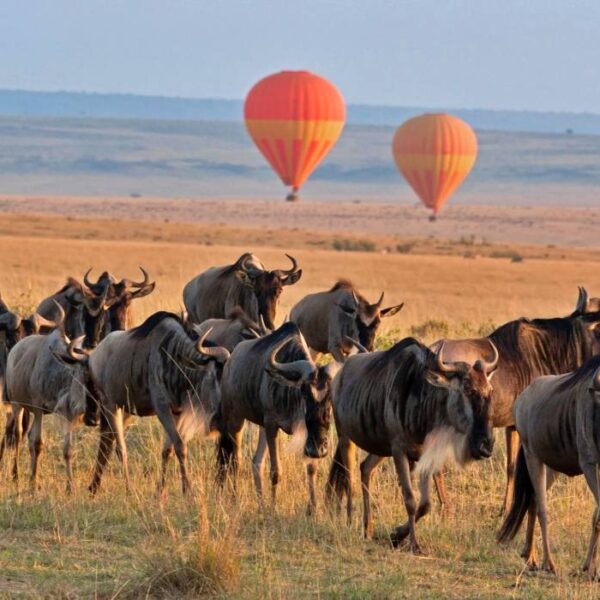Kenya is a paradise for photographers and wildlife enthusiasts alike. Its diverse landscapes and thriving wildlife populations offer unmatched opportunities to capture some of the most iconic animals on the planet. Among the most sought-after photographic subjects are the Big Five—the lion, leopard, elephant, buffalo, and rhinoceros. Once considered the most difficult animals to hunt, today they are the stars of any safari adventure, particularly for photographers eager to capture their majesty on film.
If you’re planning a photographic safari in Kenya and hope to capture the Big Five in all their glory, this guide will help you prepare for the experience of a lifetime.
1. Best Destinations for Photographing the Big Five
While the Big Five can be found in several national parks and reserves across Kenya, certain locations offer a higher likelihood of capturing each of these magnificent creatures on camera. Here are the top destinations to visit on your photographic safari:
- Maasai Mara National Reserve: Renowned for its vast savannahs and abundant wildlife, the Maasai Mara is the crown jewel of Kenya’s safari destinations. The park’s dense lion population, along with elephants, buffalo, and the elusive leopard, makes it an ideal spot to photograph four out of the five. Rhino sightings are rare, but not impossible.
- Amboseli National Park: Known for its iconic views of Mount Kilimanjaro, Amboseli is one of the best places to photograph elephants up close. Large herds of elephants roam the park’s plains, and the dramatic backdrop of Africa’s tallest mountain makes for incredible photo compositions.
- Lake Nakuru National Park: If you’re hoping to capture rhinos, Lake Nakuru is one of Kenya’s most reliable locations for these endangered animals. Both black and white rhinos can be found here, along with buffalo and occasional leopard sightings. The park is also famous for its flamingos, which create a pink canvas across the lake’s surface.
- Tsavo East and West National Parks: Covering massive areas of wilderness, Tsavo is less crowded than the Maasai Mara but offers stunning photographic opportunities, especially for elephants and buffalo. The dramatic landscapes and vibrant red soil make for unique wildlife shots.
- Ol Pejeta Conservancy: This private conservancy is home to a high density of black rhinos and the last remaining northern white rhinos, making it a prime destination for rhino photography. In addition to rhinos, you can spot elephants, lions, leopards, and buffalo.
2. Timing is Key: Best Time to Capture the Big Five
Timing your visit to Kenya is essential to maximizing your chances of photographing the Big Five.
- Dry Season (June to October): The dry season is ideal for wildlife photography. With less vegetation and scarce water sources, animals tend to congregate around waterholes, making them easier to find and photograph. This period also coincides with the Great Migration in the Maasai Mara, where over a million wildebeest and zebras cross the plains, attracting predators like lions and leopards.
- Early Morning and Late Afternoon: For the best lighting and animal activity, plan your game drives for the early morning and late afternoon. The soft, golden light of sunrise and sunset, known as the “golden hour,” provides a stunning backdrop for wildlife photography, enhancing colors and shadows.
3. Essential Gear for a Photographic Safari
To capture high-quality images of the Big Five, you’ll need the right equipment. Here are the essentials to pack:
- Camera with Good Zoom Capabilities: A DSLR or mirrorless camera with interchangeable lenses is ideal for safari photography. A telephoto lens (200mm to 600mm) is crucial for capturing animals from a distance, while a wider lens (24mm to 70mm) will help you capture landscapes and close-up shots when animals come near your vehicle.
- Tripod or Bean Bag: A stable platform for your camera is essential, especially when using long lenses. A tripod or bean bag will help minimize camera shake during long shots, ensuring your images remain sharp.
- Extra Batteries and Memory Cards: Safari days are long, and you don’t want to miss a perfect shot because your battery died. Bring extra batteries and plenty of memory cards to store all your images.
- Polarizing Filter: This filter can help reduce glare and enhance the colors of your photos, particularly in bright sunlight. It’s especially useful when photographing near waterholes or during midday.
- Camera Bag: A sturdy, weather-resistant camera bag will protect your gear from dust, rain, and bumps during your safari.
4. Tips for Capturing Stunning Shots of the Big Five
- Know Your Subject: Research the behavior of the Big Five before your trip. Understanding their movements and tendencies can help you anticipate action and position yourself for the best shots. For example, lions are most active in the early morning and late afternoon, while elephants may gather at waterholes during the hottest parts of the day.
- Focus on the Eyes: The eyes are the most expressive part of an animal’s face, and capturing them in sharp focus brings life to your images. Use your camera’s autofocus system to lock onto the eyes for a powerful, intimate photograph.
- Use Natural Light: The golden hours around sunrise and sunset provide soft, diffused lighting that enhances the texture and colors of the animals and the landscape. Avoid the harsh midday sun, which can create strong shadows and washed-out colors.
- Tell a Story: Don’t just focus on close-up portraits of animals—capture the broader context. Include elements of the landscape, such as Mount Kilimanjaro in Amboseli or the sprawling savannah in the Maasai Mara. These environmental shots provide a sense of place and scale, helping to tell the story of the animal in its natural habitat.
- Patience is Key: Wildlife photography requires patience. You may need to wait for hours to get the perfect shot, but when that moment arrives—whether it’s a lioness hunting or an elephant mother and calf walking in tandem—it’s all worth it.
5. Ethical Photography Practices on Safari
While capturing the perfect shot is important, so is respecting the wildlife and their habitats. Here are some ethical guidelines to follow:
- Keep a Safe Distance: Avoid getting too close to animals, as this can disturb them or provoke aggressive behavior. Use a telephoto lens to photograph animals from a respectful distance.
- Don’t Disturb Wildlife: Never pressure your guide to drive off-road in protected areas to get a closer view. This can damage the environment and disturb the animals. Stick to designated roads and respect park rules.
- Respect Local Communities: Many safaris pass through Maasai or Samburu villages. If you wish to photograph people or their homes, always ask for permission and be mindful of their culture and traditions.
6. The Power of the Big Five on Camera
Each of the Big Five offers unique photographic challenges and rewards:
- Lions: Known as the kings of the jungle, lions are one of the most popular subjects for photographers. Capture them lounging in the grass, roaring at sunrise, or engaging in a hunt.
- Leopards: These elusive cats are difficult to spot, but with patience, you can capture them lounging in trees or prowling in the shadows. Use your zoom lens to photograph them from a distance without disturbing their solitary nature.
- Elephants: Kenya’s elephants, particularly in Amboseli, are majestic creatures that roam in large herds. Capture them with Kilimanjaro as a backdrop for a breathtaking scene.
- Buffalo: Often found in large herds, buffalo can be captured in dynamic group settings or as powerful individuals silhouetted against the sky.
- Rhinos: Rhino sightings are rare, so if you’re lucky enough to find one, take your time capturing this critically endangered animal. Both black and white rhinos offer opportunities for stunning close-up shots.
Conclusion: Capture the Magic of Kenya’s Big Five
A photographic safari in Kenya offers endless opportunities to capture the beauty, power, and majesty of the Big Five. With the right preparation, gear, and timing, you’ll return home with not only incredible images but unforgettable memories of your time in the wild. Whether you’re an experienced photographer or just starting out, Kenya’s landscapes and wildlife promise an extraordinary adventure through the lens.
So grab your camera, head into the wild, and prepare to create lasting photographic memories of Kenya’s Big Five.



